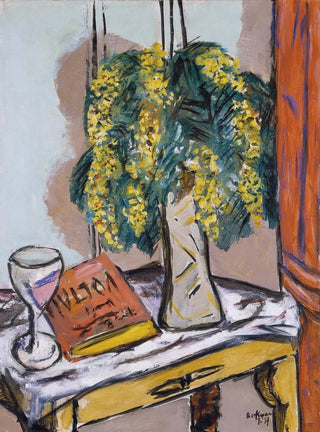Art print | Still life with mimosas - Max Beckmann


View from behind

Frame (optional)
Max Beckmann's Art print of Nature morte aux mimosas is a piece that transcends mere arrangement of inanimate objects to immerse us in a vibrant universe of colors and emotions. The artist, known for his bold approach and ability to capture the essence of life through carefully orchestrated compositions, invites us to contemplate the fleeting beauty of nature. This work, imbued with poetry, evokes sensations of softness and melancholy, while revealing the complexity of the relationships between its elements. Through this painting, Beckmann does not simply depict mimosas; he offers us a true sensory journey, an immersion into a world where every detail matters.
Style and uniqueness of the work
The Art print of Nature morte aux mimosas stands out for its daring use of color and light. Beckmann, master of cubism and expressionism, plays with shapes and shadows to create an atmosphere that is both intimate and dynamic. The mimosas, with their bright yellow flowers, seem to vibrate on the canvas, while other elements of the composition, such as ceramic objects and textured background, contribute to a captivating visual harmony. The contrast between the softness of the flowers and the robustness of the surrounding objects evokes a duality at the heart of Beckmann's work. Every brushstroke is loaded with meaning, every color carefully chosen to evoke an emotional response. This Art print is an invitation to see beyond appearances, to feel the depth of the feelings that art can convey.
The artist and his influence
Max Beckmann, an emblematic figure of 20th-century art, distinguished himself with his unique vision and innovative approach. Born in 1884 in Leipzig, Germany, he experienced tumultuous periods that profoundly marked his work. Beckmann was influenced by the historical events of his time, notably the two world wars, which is reflected in the tension and psychological depth of his creations. His style, blending realism with symbolic elements, paved the way for many contemporary artists. By integrating themes of the

Matte finish

View from behind

Frame (optional)
Max Beckmann's Art print of Nature morte aux mimosas is a piece that transcends mere arrangement of inanimate objects to immerse us in a vibrant universe of colors and emotions. The artist, known for his bold approach and ability to capture the essence of life through carefully orchestrated compositions, invites us to contemplate the fleeting beauty of nature. This work, imbued with poetry, evokes sensations of softness and melancholy, while revealing the complexity of the relationships between its elements. Through this painting, Beckmann does not simply depict mimosas; he offers us a true sensory journey, an immersion into a world where every detail matters.
Style and uniqueness of the work
The Art print of Nature morte aux mimosas stands out for its daring use of color and light. Beckmann, master of cubism and expressionism, plays with shapes and shadows to create an atmosphere that is both intimate and dynamic. The mimosas, with their bright yellow flowers, seem to vibrate on the canvas, while other elements of the composition, such as ceramic objects and textured background, contribute to a captivating visual harmony. The contrast between the softness of the flowers and the robustness of the surrounding objects evokes a duality at the heart of Beckmann's work. Every brushstroke is loaded with meaning, every color carefully chosen to evoke an emotional response. This Art print is an invitation to see beyond appearances, to feel the depth of the feelings that art can convey.
The artist and his influence
Max Beckmann, an emblematic figure of 20th-century art, distinguished himself with his unique vision and innovative approach. Born in 1884 in Leipzig, Germany, he experienced tumultuous periods that profoundly marked his work. Beckmann was influenced by the historical events of his time, notably the two world wars, which is reflected in the tension and psychological depth of his creations. His style, blending realism with symbolic elements, paved the way for many contemporary artists. By integrating themes of the






